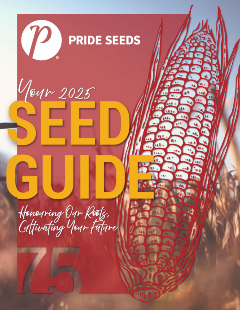___________________________________________________________________________________________________________________________________________

2024-2025 PRIDE Seeds Product GuideYou can find all of our products on the website, including supporting performance data and create your own personalized guide called My Guide. You can also download the digital version of our printed product guide which includes product comparison charts. |
Soybean School: Long-season varieties create yield risk and rewards
The variety and maturity group selections soybean growers make can have significant impact on how a variety develops throughout the season and its final yield.
On this episode of the RealAgriculture Soybean School, PRIDE Seed agronomist Matt Chapple looks at how two varieties with different maturity ratings perform in side-by-side plots under the same growing conditions in southwestern Ontario.
Comparing 1.7 and 3.0 maturity rated soybeans, Chapple notes that the 1.7 or shorter-season bean will likely reach the finish line 10 days earlier than the longer-season 3.0 variety. In this video, filmed mid-August, the early variety is about one growth stage ahead of the later variety — R5 versus R4. The early bean shows well-developed pods from top to bottom of the plant, while the late bean features longer nodes and more branching with much more flower and pod development still to come.
It’s at this point that growing conditions can significantly impact the final yield of each variety. Chapple notes the 1.7 variety has already made about 50 percent of its yield potential; that means there’s less risk of disease coming in and impacting the crop at this point. Seed size is also less dependent on August growing conditions, including August rains that typically make grain.
The later variety has more growing season to navigate. It’s made only about 25 percent of its yield potential. Disease and drought stress are more of a concern, but the variety carries much higher upside yield potential, about 10 to 20 percent, notes Chapple.
Mother Nature, however, will play a bigger role in determining the yield of the long-season variety based on growing conditions, including water, temperature and day length, at the back end of the growing season. Overall, Chapple recommends growers maximize their growing environment and yield opportunity by planting full-season soybeans for their region or growing area. He says there is far greater upside potential to make yield in September than rushing to the finish line right after Labour Day when there’s still plenty of growing season ahead.
(Note: Article is originally published at RealAgriculture.com)
THE PRIDE SEEDS ADVANTAGE
Farming is one of the most demanding industries in the world, subject to a variety of factors such as time, weather, and global pressures. You know this every time you look out the window and think about the field in front of you. Growers and dealers deserve an advantage: The PRIDE Seed Advantage.
LEARN MORETHE PRIDE SEEDS ADVANTAGE
Every year PRIDE Seeds works hard to produce leading-edge products that enable success where it matters most, on your farm. Our dedicated team strives to provide sales expertise, agronomy support, quality production, and service tailored to meet your needs.
LEARN MORE
-7.png?sfvrsn=87920db3_3)

Leave a commentOrder by
Newest on top Oldest on top